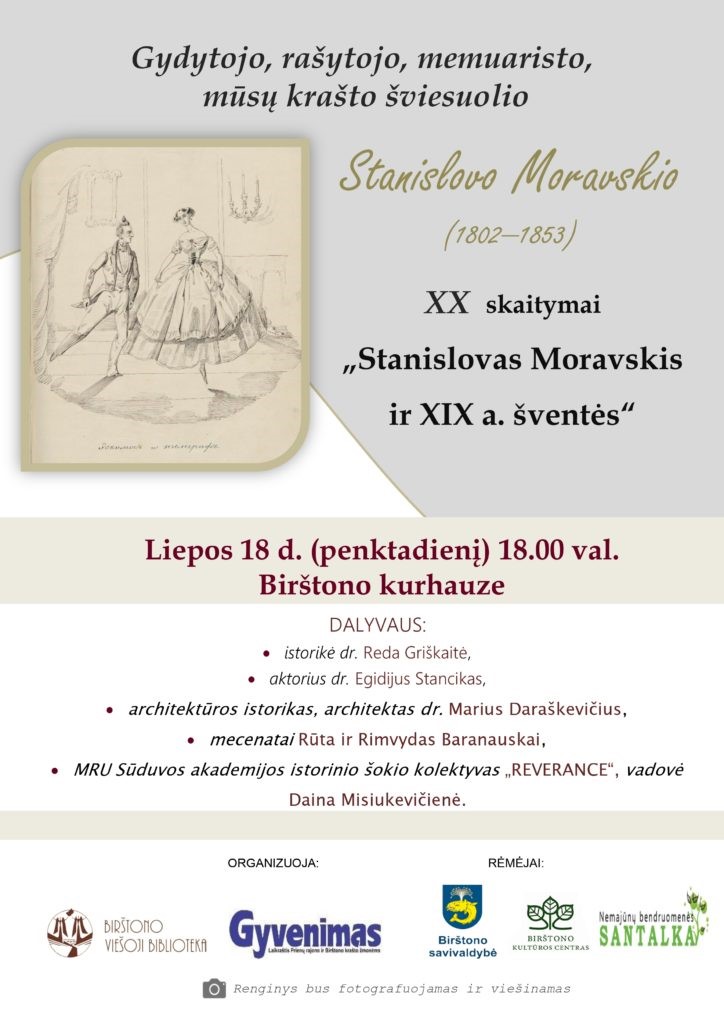Stanisławas Moravskis XX Readings "Stanisławas Moravskis and 19th Century Celebrations"
Links
about
Right next to Birštonas, in the Ustronė Manor (now Jundeliškė), the doctor and writer Stanislovas Moravskis (1802–1853), who lived and worked in the Ustronė Manor (now Jundeliškė), never ceases to amaze us with his versatile abilities, which also give us the opportunity to talk about the most diverse topics – starting with science, patriotism and freemasonry, ending with music, art and flowers (these are all the topics of Moravskis’s annual readings). However, Moravskis’s work is also an inexhaustible source for the history of everyday life in Lithuania in the 19th century. One of the most prominent events of 1848 The episodes of the work "A Few Years of My Youth in Vilnius (1818–1825)" written in 1818 describe in detail the entertainments of that time: banquets, dances, redutas (public masked balls, which anyone who wanted to could participate in, regardless of their social status), masquerades (entertainments of the nobility, the participants of which were required to wear masks and characteristic costumes).
All these entertainments were part of the so-called Carnival (otherwise known as Mardi Gras, Shrove Tuesday, Devil's Day), which lasted from the beginning of the New Year (usually from the Feast of the Three Kings, i.e. January 6) to Ash Wednesday, i.e. the first day of Lent. The tradition is associated with the Grand Tour (Great Journeys), which became popular at the end of the 18th century, from which the nobility brought some of the spirit of the carnivals of Venice, Rome and Paris to Lithuania. Mardi Gras, or Carnival (the latter name used in the 19th century), was an integral part of life in Vilnius in the first half of the 19th century. As in other European cities, during the Carnival months, both young and old, men and women, nobles and townspeople, academics (as students were then called) and merchants, the high society and the servants of that world had fun here.
Moravskis, a participant in these festivities himself, and moreover, a keen observer, left excellent descriptions of the reveling carnival Vilnius; Vilnius, to which the entire Lithuanian nobility would come from their estates for that period. Despite the painful political situation – uprisings and losses, Lithuania in the 19th century also lived an ordinary life, in which both masquerade and dance found their place. As today, then (especially then) dance was not only a sphere of music, communication, not only community and love for people, but also an expression of patriotism and strength.
This year, the joyous and beautiful anniversary of Stanislovas Moravskis' readings - the twentieth anniversary - prompted us to talk about such a fun topic.
Dr. Reda Griškaitė will give a presentation "We dance, so we are still here", in which she will present the genesis of masked balls and talk about the ancient forms of entertainment during the carnival period.
Dr. Marius Daraškevičius will talk about the masquerade balls he has been organizing in Vilnius for several years and will demonstrate a carnival mask.
Actor Dr. Egidijus Stancikas will read excerpts from Stanislovas Moravskis's work.
The event will be highlighted by the program of the historical dance collective "Reverance" of the Sūduva Academy of Mykolas Riomeris University, led by Daina Misiukevičienė.
Stanislovas Moravskis' readings will take place on July 18 (Friday) at 6:00 p.m. at the Birštonas Kurhaus. Before the readings, we invite you to visit the eternal resting place of the Ustronė Hermit – the Nemajūnai Cemetery Chapel.



